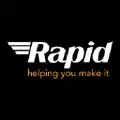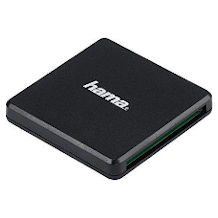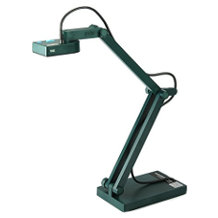Paper shredder purchasing advice: how to choose the right product
- What you need to know
- Shredders destroy documents to make sure the information can’t be read by anyone.
- How fast and how many sheets a shredder can cut simultaneously depends on the model.
- Some models have an automatic paper feeder.
- There are different shredding types – the most common is the cross-cut.
- The smaller the paper particles, the less likely someone will be able to retrieve any information.
- Some shredders can also cut staples, paperclips, CDs, and bank cards.
- Features like a small intake can help prevent injuries.
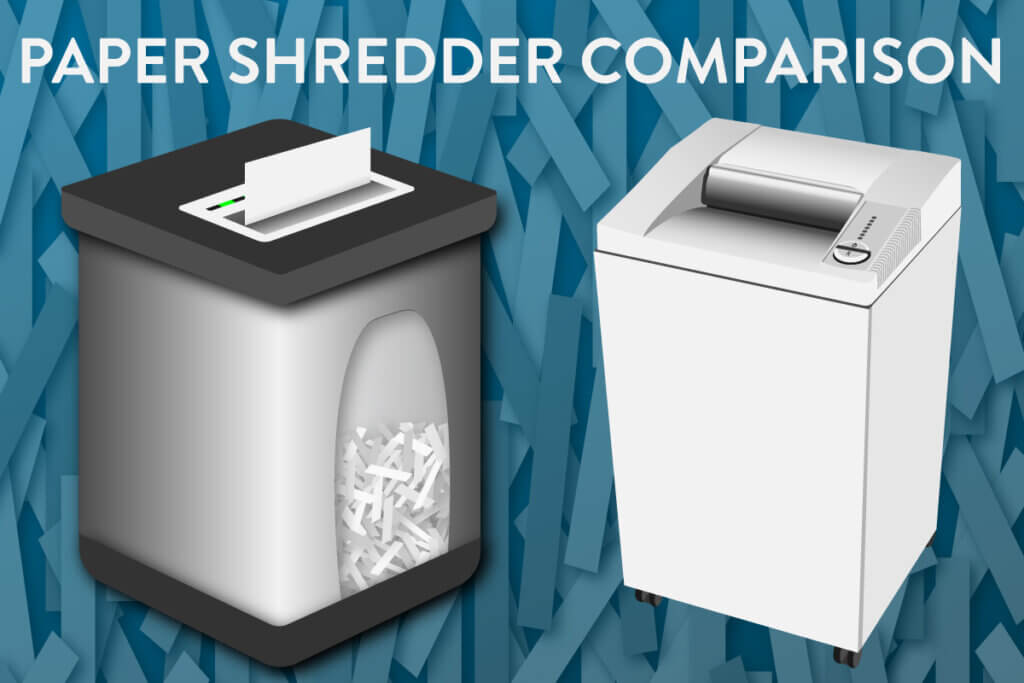
Do I need a shredder?
Shredders, as their name suggests, cut up documents so that they are destroyed – nobody will be able to access any sensitive information they had on them. Whether you’re in the office or at home, you don’t want things like invoices, government documents, or blueprints falling into the wrong hands. Thieves can steal personal information like addresses, social security numbers, and birthdays, or even your bank details. Data breaches are reputation-destroying for a lot of companies. While there isn’t one single data protection law in the US, in Europe, GDPR legislation means that shredders are also legally necessary in order to comply with the rules. The laws state that documents with personal information must be destroyed before being disposed of, otherwise there can be serious fines. While shredders are essential for commercial use, because of the aforementioned dangers, they are also an important tool for use at home.
Features and cuts
If you don’t properly destroy documents, you’re running the risk that they fall into the wrong hands. In the past, sensitive information used to be burnt, but this comes with its own pitfalls – nobody wants an out-of-control fire. Moreover, burning doesn’t always completely destroy paper which means some information can be retrieved.
The first paper shredder was designed by Adolf Ehinger in the 1930s. His shredder worked using a crank and was based on a pasta machine. Nowadays, shredders are motorized, but the basic principles of Ehinger’s machine have stuck: shredders work using interlocking blades which turn in opposite directions. The circular cutters rotate into each other so that paper gets pulled down through them. The more cutters in a shredder, the smaller the paper pieces will be. The length of the paper strips depends on how large the sheet of paper originally was.
There are also other kinds of cut styles, such as shredders which also make diagonal cuts in order to increase security – as before, the more cuts, the less likely it is that someone will be able to reconstruct a page. Read on for an overview of these different cut styles.
Cut styles
Strictly speaking there are only really two kinds of shredder cut styles: strip-cuts and cross-cuts. As the name suggests, strip-cut shredders slice paper into strips. The width of these strips depends on the shredder model. Thin strips are safer, because the thinner the strip, the harder it is to re-assemble them. However, even more secure than strip-cuts are cross-cuts: these cut the paper into tiny particles which are even harder to re-assemble.
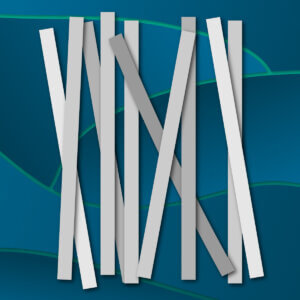
Strip-cut
Strip-cuts are the simplest shredding technique. The paper gets cut into strips that are usually between 2 and 12mm wide – width depends on the number of cutting blades. These shredders don’t make any horizontal cuts, so the length of the strips just depends on the original paper size. Piles of strip-cut paper take up more space than the equivalent cross-cut amount, so you’ll have to empty the collection bin more often. Strip-cuts can shred multiple pages simultaneously. In general, strip-cut shredders are quieter than ones with other cutting technologies.
Advantages
- Can cut more pages simultaneously than cross-cut
- Quieter than other cutting styles
Disadvantages
- Less secure than other cuts
- Shredding bin needs to be emptied more often than other cuts
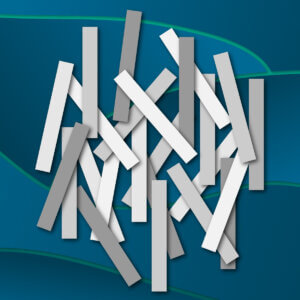
Cross-cut
Cross-cut shredders have extra blades on the edges of the cutting blades which slice the strips into particles. These horizontal cuts increase the number of paper pieces, which makes the page much harder to re-construct.
Advantages
- More particles mean more security
- Shredding bin fills up slower
Disadvantages
- Can’t cut as many pages at once
- Louder than strip-cut shredding
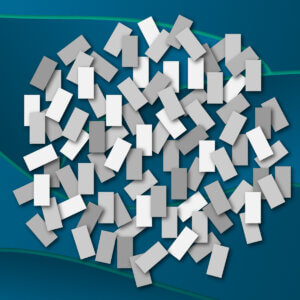
Micro-cut
Micro-cuts are a kind of cross-cut. The paper gets cut into extremely small particles by multiple blades, making it nearly impossible to put them back together again. This technology is used for when security is of paramount importance, for example, when intelligence agencies need to destroy sensitive information.
Top unit
Most shredders come as complete devices, comprised of a cutting machine and a collection basket. A lot of models have a safety feature which means that the blades will only work when the basket is attached to the top unit. This prevents any contact with the underside of the cutting blades which could lead to injury. When the basket is full, lots of models will automatically switch off the blades – you’ll either have to empty the basket or push a button to force the shredder to keep cutting.
There are some shredders on the market which only come with the top shredding unit, so you can mount them directly onto a wastepaper bin. This kind of shredder means you won’t have to empty any collection bins, which can be especially useful in offices. Since bins come in different shapes and sizes, these shredders usually have an adaptive mount to make sure they always are installed securely.
Shredders with doors
Shredders with doors are quite common on the market. Instead of having to take off the top unit to empty the collection basket, you just have to open a door to access the paper shreds. These models usually have a larger collection basket than standard shredders, but just like the normal models, they have a security system that means the blades will only spin when the door is closed.
Mini hand shredder
Hand shredders aren’t very common. They look a bit like hair straighteners, and you have to hold down a button the whole time you’re shredding a piece of paper, otherwise the blades will stop. This is a niche product, really only for people that rarely need to shred documents and want something small and cheap.
Manual shredders
Manual shredders work using a crank arm instead of a motor. You have to feed the paper in with one hand and turn the crank with the other. These shredders are best for small quantities of documents, and most can handle up to a folded sheet of A4. Some models can do cross-cuts.
Manual shredders aren’t suitable for thick paper, cards, or shredding multiple pages at once because they don’t have enough power. Such shredders almost always comes with a collection bin. They move around quite a lot while you crank, so a model you have to attach to a normal bin doesn’t make much sense as it would be too unstable. Manual shredders aren’t as secure as motorized ones, but they are cheaper, quieter, and don’t require electricity.
Advantages
- Comparatively cheaper
- Very quiet
- No need for a power source
Disadvantages
- Can’t shred multiple sheets of paper
- Tiring to use
- Usually no micro-cuts
Safety and security
In the EU, shredder security levels have been standardized since 2012 under the DIN 66399 regulations.
What is DIN 66399?
DIN 66399 offers a framework so that you know exactly what level of security you’re getting from a shredder. There are 7 DIN levels, each of which correspond to increasing levels of security. The table below explains the different safety levels covered by the standard.
| Safety class | Description | DIN level |
| 1 – for personal documents that need a normal level of security | Financially sensitive documents | 1 – 3 |
| 2 – for confidential data that needs a high level of security | Documents which threaten economic status or reputation | 3 – 5 |
| 3 – for extremely confidential data that needs a very high level of security | Documents which endanger life, limb, or freedom | 4 – 7 |
The three safety classes indicate the different levels of safety demanded by confidential documents. The DIN levels determine how securely they need to be destroyed. In the higher levels, there is no chance of re-assembling any papers – they are completely safe from falling into the hands of a third party. Data that falls into a certain security class needs to be destroyed in accordance with the corresponding DIN level, so make sure any shredder you buy has these capabilities.
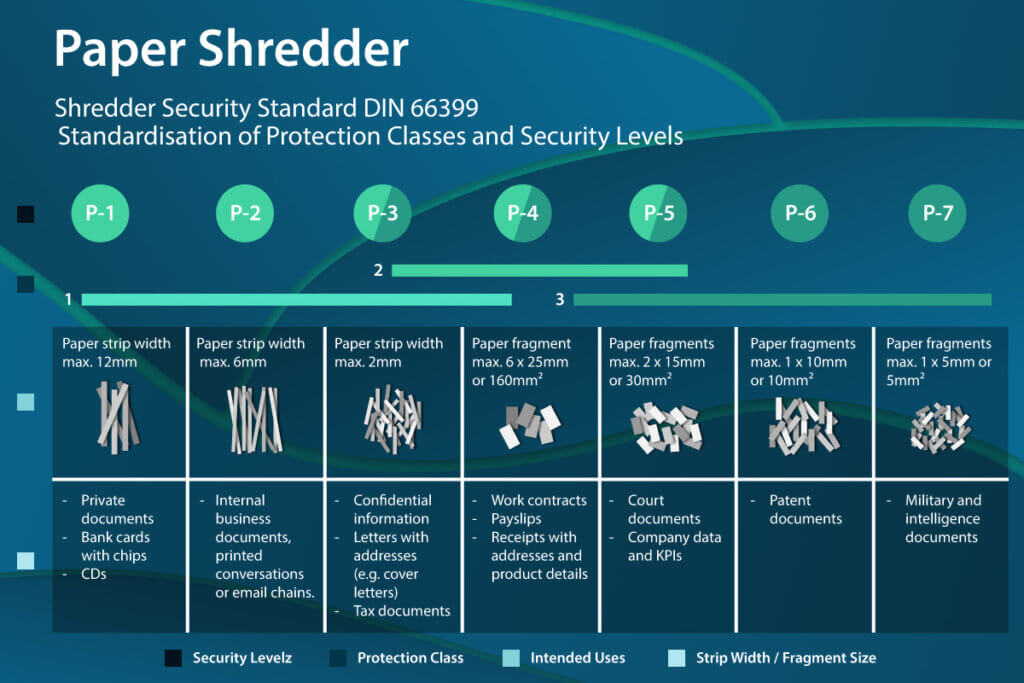
What safety level do I need?
Shredders with DIN level 1 can only cut paper into relatively wide strips. As a result, they aren’t really suitable for confidential documents. Level 2 is for things like internal office communications. Level 3 is for private information such as addresses or tax IDs. Levels 1-3 are strip-cuts, but level 4 is a cross-cut: it is suitable for things like employment contracts, pay slips, share slips, and bank statements. Level 5 is suitable for court documents. If you have data that could compromise a lot of money, say, a patent document, then level 6 is necessary. The particles from this level are at most 10mm long and 1mm wide. DIN level 7 is for military and intelligence services – the particles are half the size of level 6.
More buying tips
There are a number of factors that go along with shred size which can help you choose the right shredder for your needs.
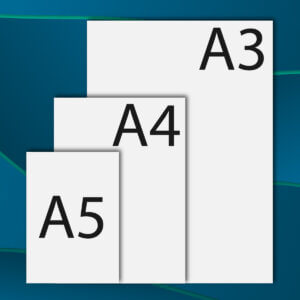
Document size
Most paper shredders are designed to cut A4 sheets of paper, since it’s the most common size. For larger sheets (A3 or A2) you may need a special shredder, which can get expensive. However, so long as the motor is strong enough, you should be able to fold bigger sheets down to size.
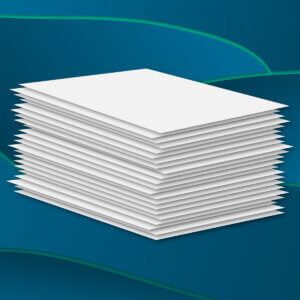
Number of sheets
If you need to shred lots of documents, then pay attention to how many sheets a shredder can get through simultaneously – this will make things much quicker! Some shredders have paper trays, which means you can just leave a pile for the machine to work through rather than having to stand there and feed them in.
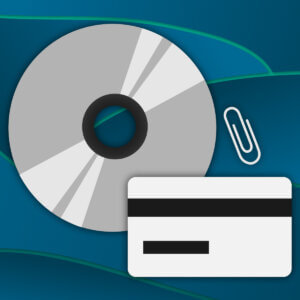
Just paper?
Getting a shredder that can cut through more than just paper is very useful. Being able to cut through bank cards and CDs is convenient, but really, having a shredder that won’t jam up because of staples or paperclips is extremely helpful.
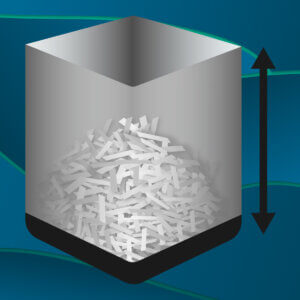
Collection bin size
The size of the collection bin determines how often you need to empty it. For home use, something between 5 and 12 liters (1.3 to 3.2 gallons) will be fine. For small offices that use the shredder daily, something between 12 and 40 liters (3.2 to 10.5 gallons) will be good. Larger offices need at least 40 liters, up to 150 (40 gallons).
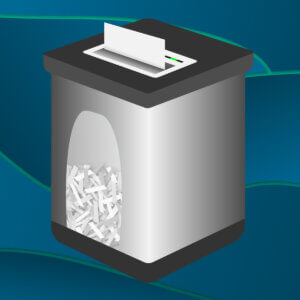
Fill level indicator
A fill level indicator is a useful feature on some shredders, particularly if the collection bin is opaque. If the bin is full, you won’t be able to shred anything, so having an LED to indicate if this is the case can be very helpful.
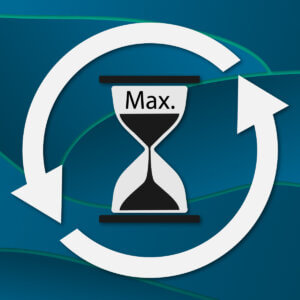
Maximum operating time
To prevent damaging the motor, nearly all shredders have a system which protects against overheating. Once the blades get too hot, the shredder will automatically shut off to cool down. Some higher-end shredders have fans to extend the operating time, but the cheaper models do not.
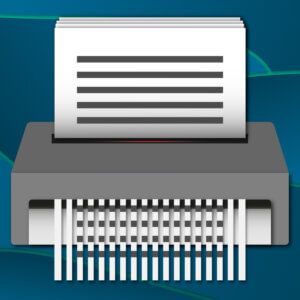
Auto standby
Some shredders have an automatic standby mode, which means that if no new sheets of paper are inserted it will turn off, and if paper is put in then it will turn on. This saves energy and is a useful safety feature.

Reverse
Almost all shredders have a reverse feature in case of a jam. If the paper gets stuck, you can use the reverse mode to unblock the jam.
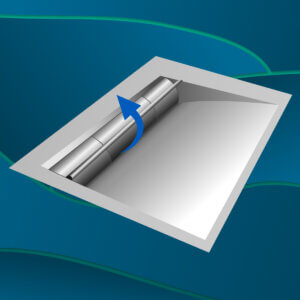
Safety flap
A narrow safety flap prevents unwanted things like fingers or ties from going in the shredder. The narrow slit allows single sheets to enter – if you want to shred multiple sheets at once, you’ll have to remove the cover.

Operating noise
How loud a shredder is when it is working is an important thing to consider, especially if it is going to be used frequently in an office. Loud shredders quickly get annoying! Unfortunately, most manufacturers don’t specify how loud their devices are in decibels which makes comparing them more difficult.
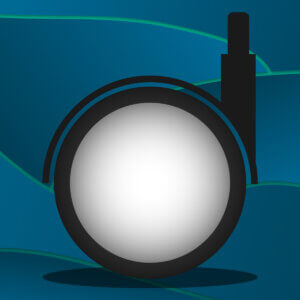
Wheels
Large shredders are tricky to move, especially when they’re full. Going for a model with wheels provides a lot of flexibility.
Maintenance
Over time, the cutting blades on a shredder will wear out. This happens more quickly with cross-cut shredders than with strip-cut ones. Regularly oiling your shredder will prevent it from blunting and will also make sure that the paper continues to feed in properly. Maintaining your shredder properly will also prevent it from becoming too noisy. The higher the security level, the more often you’ll need to do some maintenance. To oil your shredder, you’ll either need to drip some suitable lubricant onto the blades or use special oil-soaked paper.
Images 1-16: © FinalCheck

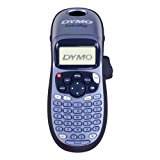

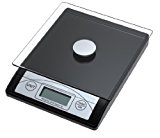
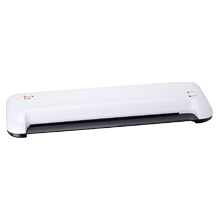
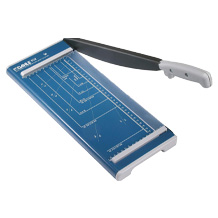
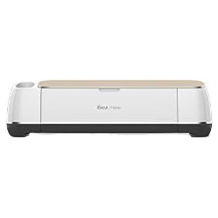

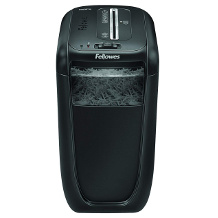
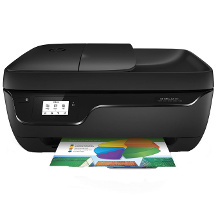
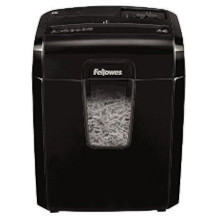
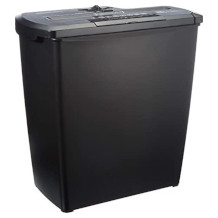
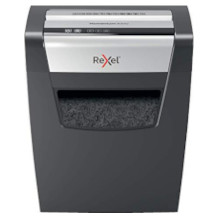
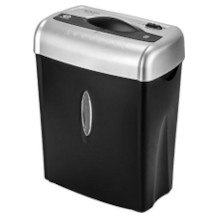
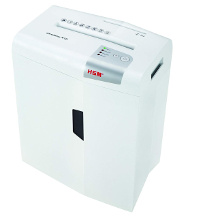

 2,313 reviews
2,313 reviews


